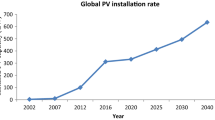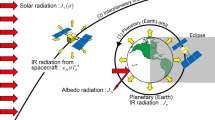Abstract
Temperature is an extremely important parameter for the material of the space-borne infrared detector. To cool an HgCdTe-infrared detector, a Stirling-type pulse-tube cryocooler (PTC) has been developed based on a great deal of numerical simulations, which are performed to investigate the thermodynamic behaviors of the PTC. The effects of different low temperatures are presented to analyze different energy flows, losses, phase shifts, and impedance matching of the PTC at a temperature range of 40–120 K, where woven wire screens are used. Finally, a high-efficiency coaxial PTC has been designed, built, and tested, operating around 60 K after a number of theoretical and experimental studies. The PTC can offer a no-load refrigeration temperature of 40 K with an input electric power of 150 W, and a cooling power of 4 W at 60 K is obtained with Carnot efficiency of 12%. In addition, a comparative study of simulation and experiment has been carried out, and some studies on reject temperatures have been presented for a thorough understanding of the PTC system.
















Similar content being viewed by others
Abbreviations
- A :
-
Area
- u :
-
Velocity
- P :
-
Pressure
- F :
-
Viscous pressure gradient
- C v :
-
Isochoric specific heat
- C p :
-
Isobaric specific heat
- T :
-
Temperature
- k :
-
Thermal conductivity
- R :
-
Gas constant
- Bl :
-
Force factor
- c :
-
Damping coefficient
- R a :
-
Impedance real part
- X a :
-
Impedance imaginary part
- Relec:
-
Electric resistance
- k s :
-
Spring stiffness
- m :
-
Moving mass
- W pv :
-
Acoustic power
- Welec:
-
Electric power
- Q :
-
Energy flow
- t :
-
Time
- x :
-
Longitude coordinate
- ρ :
-
Density
- α :
-
Heat transfer coefficient
- η :
-
Electric-to-acoustic efficiency
- ω :
-
Angular frequency
- θ :
-
Angular
- a:
-
Acoustic load
- m, o:
-
Mean
- v:
-
Isochoric
- p:
-
Isobaric
- Loss-reg:
-
Regenerator loss
- Reg:
-
Regenerative
- Cond:
-
Thermal conduction
- Res:
-
Flow resistance
- pv:
-
Acoustic
- Elec:
-
Electric
- \( \bullet \) :
-
Derivative
- \( | {} | \) :
-
Magnitude of complex number
References
Frank Pobell, Matter and Methods at Low Temperatures (Springer, Berlin, 2007)
A. Rogalski, Recent progress in infrared detector technologies. Infrared Phys. Technol. 54, 136–154 (2011)
N. Rando, D. Lumb, M. Bavdaz et al., Space science applications of cryogenic detectors. Nucl. Instr. Methods Phys. Res. A 522, 62–68 (2004)
R. Radebaugh, Cryocoolers for aircraft superconducting generators and motors. Adv. Cryog. Eng. 1434, 171–182 (2012)
R. Radebaugh, Cryocoolers: the state of the art and recent developments. J. Phys. 21, 1–9 (2009)
J. Raab, E. Tward, Northrop Grumman Aerospace Systems cryocooler overview. Cryogenics 50, 572–581 (2010)
E. Tward, C.K. Chan, J. Raab, High efficiency pulse tube cooler. Int. Cryocool. Conf. 11, 163–167 (2001)
K.B. Wilson, C.C. Fralick, D.R. Gedeon, Sunpower’s CPT60 pulse tube cryocooler. Cryocoolers 14, 123–132 (2007)
T. Nguyen, G. Toma, J. Raab, HEC pulse tube cooler performance enhancement. Int. Cryocool. Conf. 17, 79–83 (2012)
W. van de Groep, J.C. Mullie, D. Willems et al., Development of a 15 W coaxial pulse tube cooler. Cryocoolers 15, 157–165 (2009)
J.Y. Hu, W. Dai, E.C. Luo et al., Development of high efficiency stirling-type pulse tube cryocoolers. Cryogenics 50, 603–607 (2010)
M.G. Zhao, Y.J. Liu, J.H. Cai et al., Experimental investigation of a 40 K single stage high frequency Pulse Tube Cryocooler. Int. Cryocool. Conf. 17, 115–119 (2012)
R. Radebaugh, Pulse tube cryocoolers for cooling infrared sensors, in Proceedings of SPIE 4130, (2000)
P.C.T. de Boer, Optimal performance of regenerative cryocoolers. Cryogenics 51, 105–113 (2011)
K.B. Wilson, R.Z. Unger, High efficiency pressure oscillator for low-temperature pulse tube cryocooler, in Proceeding of ICEC 2004, (2004)
T. Ki, S. Jeong, Stirling-type pulse tube cryocooler with slit-type heat exchangers for HTS superconducting motor. Cryogenics 51, 341–346 (2011)
R. Radebaugh, Thermodynamics of regenerative cryocoolers. in Generation of Low Temperature and It’s Applications 2003. Japan, 1–20
X. Zhi, L. Qiu et al., Review of recent development of stirling-type pulse tube cryocooler below 20 K and analysis of its loss mechanism. Cryog. Chin. 180, 25–33 (2011)
P. Kittel, Enthalpy, enthropy and exergy flow losses in pulse tube cryocoolers. Cryocoolers 13, 343–352 (2004)
K. Wang, S. Dubey, F.H. Choo et al., Modelling of pulse tube cryocoolers with inertance tube and mass-spring feedback mechanism. Appl. Energy 171, 172–183 (2016)
K.A. Gschneidner Jr., The fruition of 4f discovery, the interplay of basic and applied research. J. Alloy. Compd. 344, 356–361 (2002)
A. Zhang, Y. Wu, S. Liu et al., High-efficiency 3 W/40 K single-stage pulse tube cryocooler for space application. Cryogenics 90, 41–46 (2018)
A. Zhang, X. Chen, Y. Wu et al., Study on a 10 W/90 K in-line pulse tube cryocooler. Cryogenics 52, 800–804 (2012)
R. Radebaugh, Inertance tube optimization for pulse tube cryocoolers. Adv. Cryog. Eng. 51, 59–67 (2006)
A.K. Zhang, Y.N. Wu, S.S. Liu et al., Effect of impedance on a compressor driving pulse tube cryocooler. Appl. Therm. Eng. 124, 688–694 (2017)
Acknowledgements
This work was supported by the Natural Science Foundation of China (No. 51741610) and National key R&D program of China (No. 2016YFB0500601).
Author information
Authors and Affiliations
Corresponding author
Rights and permissions
About this article
Cite this article
Zhang, A., Liu, S. & Wu, Y. Effect of Low Temperature on a 4 W/60 K Pulse-Tube Cryocooler for Cooling HgCdTe Detector. J Low Temp Phys 192, 184–200 (2018). https://doi.org/10.1007/s10909-018-1928-x
Received:
Accepted:
Published:
Issue Date:
DOI: https://doi.org/10.1007/s10909-018-1928-x




